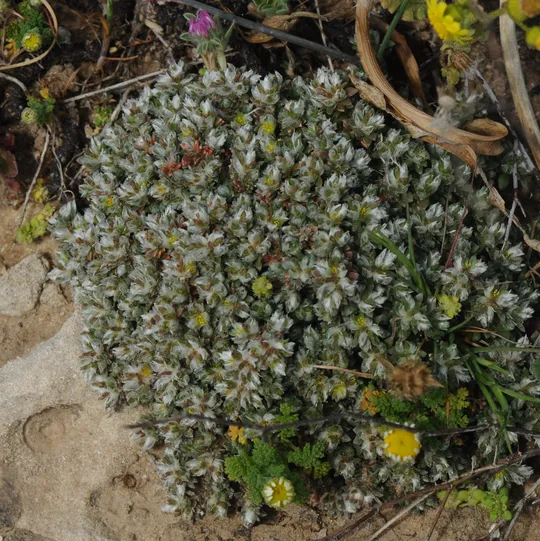Slender Bolanthus
Bolanthus filicaulis




Bolanthus filicaulis grows on only two sites in one region – the Samaria ecotone, on the eastern side of the southern Samarian anticline. One site is located 1.5 km east of Ǧ'ib'it Ruins (northwest of Uǧa), and another site is located east of the settlement of Ofra, on Tel a –Tswan, in the Binyamin Desert near the village of Muh'mas .
Limestone crevices on the eastern slope in the southern Samarian ecotone, at an altitude of 500-670 meters. Most of the collected specimens in the world are from the ecotone in the Damascus area and in the Moab and Ammon regions in Jordan.
The genus Bolanthus includes eight species of perennial herbs, some with a woody base, that grow mainly in the eastern Mediterranean – Greece, Turkey and the Levant. The genus is very close to the genus Gypsophila and in the past, it was considered a group within it. The Bolanthus species grow on mountains (at an altitude 500-2500 m), usually in limestone crevices or on rocky slopes.
On the Hermon heights and in southern Sinai Bolanthus hirsutus is found. This a vicarious species very close to B. filicaulis, which replaces it on high mountains – the Lebanon and of Anti-Lebanon Mountains and on the high southern Sinai Mountains, at altitudes above 2,000 meters. The two species are sympatric on a broad geographic scale, but they are not sympatric regionally or at the same altitudes.
The distinction between the two species is difficult, and in the past they were considered two varieties of the same species (Bolanthus hirsutus var. filicaulis; Bolanthus hirsutus var. hirsutus).They differ in their calyx, which in B. filicaulis is covered with short soft hairs, while in B. hirsutus, in addition to the short hairs there are also long split hairs.
On the Hermon heights a third species grows, B. frankenioides, which was collected in 1943 by Tuvia Kushnir at the top of Mount Hermon.
Based on the minute number of specimens, found at only two sites, during 100 years it would seem that the presence of Bolanthus filicaulis in Israel is likely to be random. If this is true, the species should not be prioritized for conservation. However, upon examination of the range of B. filicaulis in the Levant and the biogeography of the genus Bolanthus, the pair of species, B. filicaulis the B. hirsutus are both endemic to the Levant and probably their speciation center is in the Levant as well. There is no information on the prevalence of the species in Syria, but in Jordan (5-7 dried samples only) it is very rare. This is a long-lived perennial species that grows on rocks. These were the considerations that led us to include it in the list of red plants.
: A thorough survey of plants in the Benyamin and Samarian ecotones, from the mountains to the foot of the Jordan Valley should be conducted to attempt to find individual plants and populations of Bolanthus filicaulis. The plant is small and modest, and is not attractive or prominent even when in bloom. If Bolanthus plants will not be found in Israel, their seeds should be brought over from Ammon and Moab and used to populate the Wadi Yitav and the Kokhav HaShahar reserves.
Bolanthus filicaulis is found only in Israel, Jordan, Lebanon and Syria. It is very rare in Jordan, growing on rocks in the Ammon, Moab and Edom area.
Bolanthus filicaulis is a minute dwarf shrub, which was only discovered in Israel in 1983 in the southern Samarian ecotone by Orit and Tzvi Shamir. To this date, only two sites were found with very few plants. The species is endemic to Israel, Jordan and Syria. There is very little information on the general distribution of B. filicaulis. The two findings are probably not episodic, and on the contrary, the species is characteristic of the ecotone ecosystem and to the eastern section of the central mountain region in Samaria. The political situation makes conducting a plant survey in the area difficult. We believe that other populations will be discovered in the future enabling us to learn more about the plant.
Barakouda, 1962. A revision of Gypsophila, Bolanthus, Ankyropetalum and Phryna. Wentia, 9: 1-203.
Current Occupancy Map
| 1000 squre meter pixel | 5000 squre meter pixel | 10000 squre meter pixel | |
|---|---|---|---|
| number of observations | 0 | 0 | 0 |
| in total pixels | 0 | 0 | 0 |
| Family | Caryophyllaceae |
| Classification | On the endangered species list |
| Ecosystem | Semi-Steppe belt |
| Chorotype | Western Irano – Turanian |
| Conservation Site | Tel A- Tswan east of Ofra or Wadi Yitav reserve and Kokhav HaShahar |
| Rarity |
1
5
6
|
|---|---|
| Vulnerability |
0
0
4
|
| Attractiveness |
0
0
4
|
| Endemism |
0
2
4
|
| Red number |
1
4.2
10
|
| Peripherality | E |
| IUCN category | DD EW EX LC CR EN VU NT |
| Threat Definition according to the red book | Endangered |
 Based on:
Based on:






